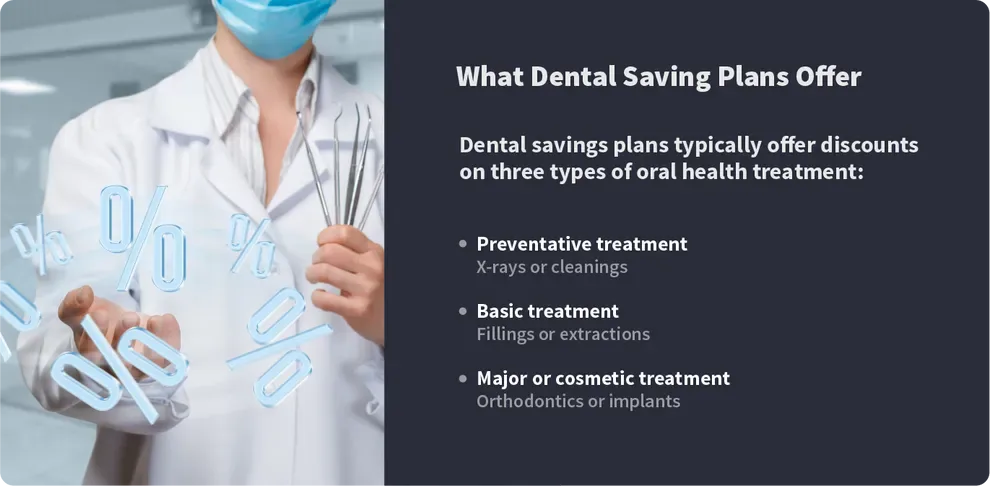What Is a Dental Savings Plan? Is It Worth Getting One?

Table of Contents
- What Is a Dental Savings Plan?
- How Do They Work?
- What Are Some Good Plan Options?
- Is a Dental Savings Plan for Me?
- References
Dental savings plans, sometimes called dental discount plans or dental discount programs, are not a replacement for dental insurance, but they can help you get access to more oral health treatments you need or want that might not be covered by your dental insurance.
Orthodontic treatments are one of the most common reasons people sign up for dental savings plans. Adult braces are rarely covered by dental insurance, and they can be very expensive without financial support.
Unlike dental insurance, dental savings plans are membership programs, so they charge a monthly or annual fee. If you need more treatment than your dental plan covers, adding a savings plan can help you get more cleanings, whitening services, and even cosmetic dentistry than you could otherwise cover on your own.
What Is a Dental Savings Plan?
Dental insurance plans cover lots of important treatments that maintain your smile. From regular cleanings to emergency dental care, most dental health insurance options provide good coverage for comprehensive treatment.
However, few dental insurance plans cover some of the treatments you might want as an adult, including braces or clear teeth aligners. Without financial support, orthodontics and cosmetic dentistry can be very expensive, so how do you get the smile you want?
Dental savings plans are a fantastic option to help you get dental care that your insurance plan might not cover. Typically, dental savings plans cost around $100 to $200 per year, but you can save anywhere from 10 percent to 60 percent on the cost of oral care services, which can ultimately save you thousands of dollars.
How Do Dental Savings Plans Work?

A dental savings plan might also be called a dental discount plan, depending on how you opt in to this program. Your employer-based dental insurance, for example, might have an associated plan that provides additional savings for certain treatments with specific dentists or dental groups.
You may also be able to set up a separate savings plan outside of your regular dental insurance that you pay into every month, giving you a certain fixed amount of money to spend on dental care of your choice.
The most common type of dental savings plan offers you discounts for treatments and services. It is a great addition to dental insurance, but it is not a replacement and not considered insurance.
Still, a dental savings plan can help you access treatment you might need, which your regular insurance will not cover. Adult braces, teeth whitening, and veneers are examples of dental treatments that your regular dental insurance is unlikely to cover even though they can make your smile beautiful.
Dental savings plans typically offer discounts on three types of oral health treatment:
Preventative treatment, including x-rays or cleanings
Basic treatment, like fillings or extractions
Major or cosmetic treatment, including orthodontics or implants
Your dental insurance likely covers some of these treatments, at least in part, but may not cover them as often or as extensively as you need. For example, your dental insurance might cover one cleaning per year, but your dentist might recommend two or three. A dental savings plan can reduce the cost of the additional cleanings.
You may also not receive full coverage for a type of treatment you need for your health. For example, a dental implant replaces a tooth that has been extracted. Replacing the tooth can prevent gum disease, teeth shifting out of alignment, and even bone loss in your jaw.
If your dentist and your health insurance agree that an implant is medically necessary for your oral health, your insurance likely covers about half the cost. What about the other half? Dental implants can be expensive, so a dental savings plan can reduce your cost even further.
Unlike dental insurance, there are no copays or deductibles with a dental savings plan — just an upfront discount on treatment.
Like health and dental insurance, you may be required to go to specific doctors or treatment centers to receive these discounts. Since you will need to choose from specified providers, it is important to get the best dental savings plan for your needs.
What Are Some Good Dental Savings Plan Options?
Many dental savings plans offer great treatment options, but there are differences between each, so a specific plan might suit you better. Here are some dental savings plans that might work well for you:
This major insurance provider has 131,000 available dentists and 67,000 pharmacies in its network, so you have numerous options for the type of treatment you want with their savings plan. Aetna’s discount card covers dental discounts and other types of health care, including eye exams and weight-loss programs.
There is a one-time $15 startup fee with Aetna. Then, low monthly payments cost less than $8 per month or as little as $75 per year for individuals. You can pay as little as $125 to cover dental discounts for your whole family for a year.
This program offers 35 percent savings, on average, for all kinds of dental and oral care services from a network of 87,000 different providers. There are three different programs offering discounts to individuals, families, and seniors. You can find great savings on orthodontics, dentures, and even some cosmetic treatment options.
Unlike many dental savings plans, Cigna does not require a one-time startup fee. Also included with the dental savings programs is an identity theft protection program and access to a comprehensive online legal forms and resource center.
With Humana’s dental discount plan on top of their dental insurance plan, you can use as many of their services as you like per year at the discounted rate for members. Discounts include up to 20 percent off the cost of orthodontics, between 20 and 40 percent savings on basic services, and an average of 37 percent savings on prescription medications. There are also discounts available on alternative therapies and vision needs.
There are over 260,000 dentists and oral care providers in the Humana network, so you have many options for care.
This plan provides huge savings, ranging from 5 percent to 60 percent on any dental care you need, including higher savings on routine care and cosmetic care than other savings plans. You can easily pay for unlimited cleanings, whitening, and even veneers. Discounts on vision and hearing needs are also available.
Plan costs start at less than $9 per month, or $99 per year, for individuals. For an individual “plus one” membership, the annual fee is $139. Family plans are $169 annually.
Is a Dental Savings Plan for Me?
Dental savings or discount plans are typically good for one year. Like dental insurance, you will need to renew your coverage after a calendar year has passed. Unlike health insurance, discount or savings plans require an annual membership fee.
If you do not use the services in your dental savings plan, you may spend more money than you save. However, if you want help paying for expensive treatments like cosmetic dentistry or orthodontics, including clear plastic aligners, a dental savings plan might be your best option, alongside regular dental insurance.
Depending on where you live, different dental savings plans may cover different providers at different rates, so investigate which plans get the best percentage reduction in your area.
